14 Early Stage Prototyping of Medical Devices
Carlye Lauff
“Never go to a meeting without a prototype” and “If a picture is worth 1000 words, a prototype is worth 1000 meetings.” These two statements, often referenced as common phrases from the design consultancy IDEO[1], help frame the mindset that we instill in designers, engineers, medical practitioners, and innovators as they aim to bring a new idea to life.
A famous example of how early-stage prototypes accelerate progress from IDEO is demonstrated in the example below[2]. On the left is an image of a prototype made from a whiteboard marker, small container, some tape, and a clip. This prototype was mocked-up during the meeting in a few minutes and was used to better communicate between the design team and client in terms of size, shape, and functionality. This accelerated the rate of learning by ensuring that the design team understood the requirements early on. The design team went on to create 30+ more prototypes, but this first model helped to solidify the direction of the product. The image on the right is of the final medical product, the Diego Surgical System, for help with sinus surgery. To hear more, you can watch this short video from David Kelly and Tom Kelley of IDEO in the footnote, where they share their approach to medtech prototyping, including discussing this example[3].
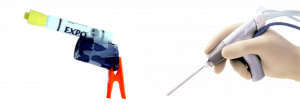
Role of Prototypes
Prototypes are essential in the product development process. But what is a prototype? We define a prototype as a physical or digital representation of aspects of your intended concept that you can then test and learn[4]. Ultimately, prototypes are meant to be tested, and then you should learn from that test to iterate and improve the design. This philosophy on prototypes aligns with the Lean Startup[5] mentality of rapid build, test, learn cycles.
Prototypes are often discussed as a risk-management tool since they help identify errors before launching a product to market. It is encouraged to prototype early and often, since if you wait until later in a project timeline then it will likely be a significant increase in cost: time, money, and resources. Additionally, prototypes are iterative artifacts that evolve in fidelity, ideally refining over time. Low-fidelity prototypes are rough approximations of the form and/or function of the intended final design, whereas high-fidelity prototypes are a closer approximation of the intended final design. Regardless of fidelity, prototypes have been proven to improve communication, aid in learning, and help to make decisions.
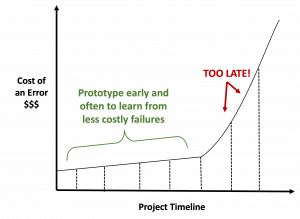
Having certain mindsets towards prototyping can help you to be more successful in your efforts. These mindsets include maintaining a non-attachment to the prototypes, having a bias towards action through making more than talking about the design, creating the quickest path to experience with the prototype, using the simplest material possible to accelerate and maximize learning, and reframing failure as a learning opportunity with each iteration.
Planning for Prototyping
Planning for prototypes is a critical first step in the prototyping process. The Prototyping Canvas is a planning tool that encourages using critical questions and assumptions to guide purposeful prototype development[6]. This canvas begins with identifying assumptions and questions that you have about the design challenge and/or prototype; these questions are divided into three categories related to desirability, feasibility, and viability of the intended product. Ultimately, the most critical assumptions and questions should be chosen to frame what you should build and test. There are portions of the canvas for identifying resources, developing a simple testing planning, sketching the intended prototypes, and reflecting on your learnings after the testing is complete. A free download of the Prototyping Canvas can be found online[7].

Prototyping Mockups for Form and Function
Low-fidelity prototypes are often referred to as “mockups” or “sketch models” in the field of product design. These synonymous names help with differentiating them from later stage “looks-like” or “works-like” models. A looks-like prototype is refined in the form, but likely not the function. A works-like prototype is refined in the functionality, but likely not the form. Prototype models can be a blend of both looks-like and works-like as well.
Prototyping for Form
Prototyping for form allows you to explore aspects such as shape, size, aesthetics, and ergonomics. Early form models can be created using simple materials like foam core and wood; they can also leverage off-the-shelf components and materials to appear more real. As the design refines, you can use digital fabrication tools like 3D printing, laser cutting, and CNC milling along with finishing techniques like sanding, priming, and painting to achieve a more polished finish.
There are some examples of prototyping for form for various medical devices shown in the images below. The first images are form models from Parker Blezek (University of Minnesota, B.S. Product Design 2022) who was working on an epilepsy treatment device. His models include using materials like foam core, off-the-shelf components like attachment wires, and 3D printing placement aids. The second set of images are form models from Mikayla Feil (University of Minnesota, B.S. Product Design 2022) who was developing a soft-goods positioner for neonatal infants in the newborn intensive care unit, also known as the NICU. Her early form models were made of clay to test multiple shapes and sizes.
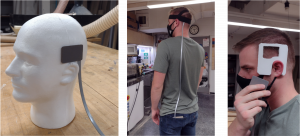
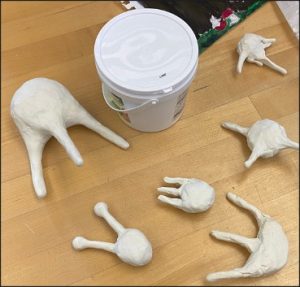
Prototyping for Function
Prototyping for function allows you to explore aspects such as feasibility, functionality, and interactivity. Building these models often requires leveraging off-the-shelf components, microcontrollers or microprocessors (like Arduino or Raspberry Pi), and creating 3D prints is the early stages. Many function off-the-shelf components can be purchased from general hardware stores or online through platforms like McMaster-Carr[8]. As the design is refined, custom components can be created using mill, lathe, casting, or another shop manufacturing process. There are many service bureaus for small scale production and prototype for validation. For example, companies like ProtoLabs[9] offer injection-molding, CNC machining, and 3D printing with quick turn-around times.
There are some examples of prototyping for function for various medical devices shown in the images below. The first images are function models from Jerritt Smith (University of Minnesota, B.S. Product Design 2022) who was working a redesign to the traditional continuous positive airway pressure device, often referred to as a CPAP device. His models include using materials like off-the-shelf components for the tubing and mask, 3D printing for the outer case and mechanisms, and Raspberry Pi and display screen with Adobe XD file for the interactive display. The second set of images are function models from Jack Garanzini (University of Minnesota, B.S. Product Design 2022) who developed an individual blood testing system in the hospital using different functional components to test, including interactive screen display with Adobe XD and iPad, cartridge insert with foam and tubing, and off-the-shelf peristaltic pump.
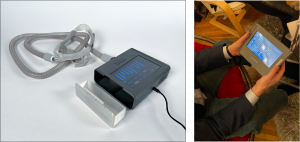

Other Prototyping Strategies
Additionally, there are more prototyping strategies to help you get into the “build to learn” mindset. These strategies, such as parallel prototyping, scaling models, storyboarding, and role playing, can help you to get started in the early stages of your work towards developing a medical device.
Parallel Prototyping
Parallel prototyping is often described when compared to sequential prototyping. Sequential prototyping is when you choose one concept and then make one prototype, test, learn, and then make the next prototype, and repeat steps of testing and learning. Conversely, parallel prototyping enables designers to compare designs directly and combine features from various concepts by prototyping multiple options at the same time. Then, these multiple concepts are tested in parallel and feedback from all the designs are used to make decisions about the next version of the product. You can parallel prototype a key function or features in various ways or you can parallel prototype multiple different directions to help you focus in on the refined direction, like the example shown below. The parallel prototyping example is from Dane Hart (University of Minnesota, B.S. Product Design 2022) and shows three concepts for a patient vital monitoring system: a standalone vital monitor, a handheld alarm, and a wrist wearable. These concepts were designed in parallel and then tested to directly compare and contrast before moving forward with an intended direction.
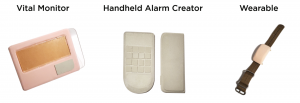
Scaling Prototype Models
Prototypes can be scaled up or scaled down in size to help with the initial versions. If the intended final design is intended at an extreme scale (very small or very large), then it can be helpful to scale the design to a more approachable model for working with your hands. For example, when developing a new robotic endoscopic device, it can be helpful to scale the model two times larger to refine the controls for the robot before scaling it down to the final size for the device. A visual of this scaled prototype model from Dr. Mark Rentschler’s Advanced Medical Technology Laboratory (AMTL) at the University of Colorado Boulder is shown below. To see a video of the testing apparatus and 2x scaled model in action please visit the website in the footnote[10].
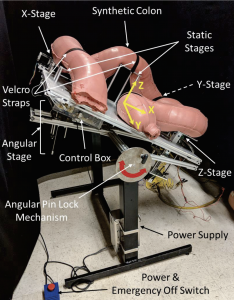
Storyboarding and Role-Playing
Storyboarding and role-playing attempt to simulate the user experience with the product, service, or system. Storyboarding can help to visualize and explain an early-stage concept to get feedback from critical stakeholders. Storyboards often have 6-10 key frames of reference that combine both visuals and words to help understand the process of using the product, often in chronological order. Role playing involves acting out the experience and bringing the storyboard interactions to life. This simulated role play is best executed when there are representative props, such as low fidelity physical models and spaces, that can help to identify pain points that might have been missed when thinking through the user experience with a product. The example below illustrates both a storyboard and role-play of using an individual blood testing system intended for a hospital. This work is from Jack Garanzini (University of Minnesota, B.S. Product Design 2022).
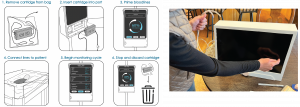
- https://www.ideo.com/ ↵
- Brown, T. (2008). Design thinking. Harvard business review, 86(6), 84. ↵
- https://www.youtube.com/watch?v=Ii1rcNJU0io ↵
- Lauff, C. A., Kotys-Schwartz, D., & Rentschler, M. E. (2018). What is a Prototype? What are the Roles of Prototypes in Companies?. Journal of Mechanical Design, 140(6). ↵
- Ries, Eric. (2011). The Lean Startup: how today's entrepreneurs use continuous innovation to create radically successful businesses . New York: Crown Business. ↵
- Lauff, C., Menold, J., & Wood, K. L. (2019, July). Prototyping canvas: Design tool for planning purposeful prototypes. In Proceedings of the Design Society: International Conference on Engineering Design (Vol. 1, No. 1, pp. 1563-1572). ↵
- www.carlyelauff.com/resources ↵
- https://www.mcmaster.com/ ↵
- https://www.protolabs.com/ ↵
- https://www.colorado.edu/lab/amtl/2018/10/06/ieee-robotics-and-automation-letters-2018-modular-endoscopy-simulation-apparatus-mesa ↵

